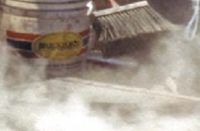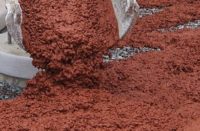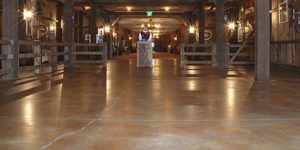 With integrally colored concrete, color problems are frequently the result of poor finishing techniques. Here are some tips for the best results:
With integrally colored concrete, color problems are frequently the result of poor finishing techniques. Here are some tips for the best results:
- Any finish used on non-colored concrete can be used on integrally colored concrete. However, it is important not to over do it.
- Light or heavily broomed surfaces will give you a different color than a smooth finish. But, if you rinse the broom between strokes, shake it out well — excess water on the surface of the concrete will streak or dilute the color.
- Over troweling will cause dark spots and poor color results if there is trowel burn
- Exposing aggregates can create contrast and often you don’t need as much pigment because you’re just trying to get the gray out of the cement, not compete with the color of the aggregate.
- Proper curing is important in ensuring consistent color.
- Don’t pour integrally colored concrete if rain is expected within 24-hours. Humidity and temperature play a role, too.
- Don’t use plastic to cover integrally colored concrete. Condensation on the underside of the plastic can weaken or streak the color on the surface.
- Efflorescence is a serious problem because you see it on on colored concrete. Prevention is the best solution for efflorescence; otherwise remove the residue by either mechanical or chemical means.
- Color matched cures can help ensure the surface coloration is consistent. On the other hand, clear curing compounds ensure the concrete’s natural beauty is visible.
- Avoid using white-pigmented curing compounds and those with a fugitive dye. Be sure to use a cure approved for use on colored concrete. They are more expensive, but they often act as a sealer, as well.
- To ensure good color results, seal with a UV-stable sealer. Any concrete left unsealed and uncleaned will tend to discolor.
- Chemical cleaning or power washing and sealing will help rejuvenate a dirty, weathered surface.
Master these concrete finishing techniques and you will be placing quality decorative concrete for years to come.















